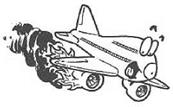Emergencies in the Air
|
|
In This Chapter
V Flying emergencies: big headlines, rare occurrences
V Off-airport and unscheduled landings
► When the engine stops running
► Ice on the wings
V Thunderstorms, microbursts, and high winds ^ Air rage—on the rise
► The Payne Stewart decompression accident
Headlines seem to trumpet some sort of airplane emergency once a week, from the minor crack-up of a small plane to a passenger jet forced to make a landing because of smoke in the cockpit.
In fact, serious aviation emergencies that endanger lives in the air or on the ground are amazingly rare. When compared to the millions of miles people travel by air every year, and the thousands of flights that take place every day, aviation emergencies are very scarce.
The Rare Emergency
Don’t take this the wrong way, but pilots are a strange breed. Every once in a while, they like a good old-fashioned emergency.
 |
Pilots train for years in handling emergencies, but almost never get to put that knowledge to the test. It’s a lot like soldiers who, after training for war, are perversely curious about trying out their skills in battle.
That’s not to say pilots like danger, but they do spend a good deal of their training time practicing how to respond to it. Airlines train their pilots using simulators so realistic that they feel almost exactly like an actual airplane—right down to the feeling of the landing gear rolling over seams in the concrete. In fact, after a few moments, everyone inside the simulator forgets they’re actually in a two-story-high cockpit mounted on a set of hydraulic pistons that tilt and jostle to simulate the motions of flight.
 |
No matter what happens during an actual flight, it’s very unlikely that things could ever get as bad as the multiple catastrophes that a sadistic simulator instructor can inflict. I know of one airline simulator training session in which one of two engines on the plane failed, all airports nearby where closed due to heavy fog, a passenger suffered a heart attack, and a fire broke out in the storage well where the landing gear was hidden away during flight—all at the same time!
Learning from the Past
Simulator instructors use their knowledge of real-life emergencies to get pilots ready for everything. For example, in July 1989, a United Airlines DC-10 piloted by
Capt. Al Haynes lost its hydraulic system, meaning that Haynes found himself flying a jetliner he couldn’t steer. The tail engine on the three-engine DC-10 he was flying had suddenly blown apart, something that wouldn’t have been terribly dangerous considering the plane had two other engines. But when it disintegrated, the engine happened to destroy the airplane’s hydraulic system, leaving the pilots no way to move the ailerons, elevators, and rudder.
Capt. Haynes, with help from Dennis Fitch, an off-duty United Airlines pilot on his way home, managed to bring the jetliner down to a runway at the Sioux City, Iowa, airport, before the plane cart-wheeled and exploded into flames. The expert piloting of Haynes and Fitch saved the lives of 184 of the 296 people on board the plane.
In this case, Capt. Haynes and his crew had never practiced that specific emergency in the simulator, partly because the scenario they encountered was thought to be impossible to create in flight. Still, the discipline and skill pilots learn in simulators prepare flight crews to respond to any emergency with a cool head and practiced hand.
|
Plane Talk One of the advantages of using computerized emulators is that instructors can program a simulator to reproduce the conditions that have led to a real-life tragedy. This allows new pilots to benefit from the painful lessons of fatal accidents, and if simulator pilots don’t learn the lessons the first time, they can practice them again and again. One of the most common in-flight emergencies that pilots now practice in simulators is the "Dallas microburst,’ the weather-related disaster that led to the deaths of 136 people on Delta Aidines Flight 191 at Dallas in 1985. Now, pilots are routinely trained to deal with the exact conditions that doomed Flight 191, and thanks to repeated simulator training, they I get it tight |
Small-airplane pilots also make use of simulated training, but not to the same degree of sophistication the airlines do. That’s because really good simulators cost tens of millions of dollars. Also, the cost of operating a small plane is relatively low, meaning that pilots and instructors can afford to practice emergency maneuvers in the actual airplane.













